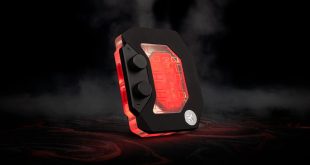We installed the modified HD6990 into our test bed. An Intel Core i7 990x system, which is CPU watercooled and running at 4.8ghz.
Test System:
Processor: Intel Core i7 990x @ 4.8ghz.
Cooler: Danger Den Watercooling.
Motherboard: Asus Rampage III Black Edition.
Memory: 12GB GSKILL 2133mhz Memory.
Power Supply: Corsair AX1200W.
Hard Drives: Patriot Pyro 120GB & 2TB Samsung hard drive.
Optical Drive: Asus BluRay drive.
Graphics: Sapphire HD6990 with reference cooler and Arctic Cooling Accelero Twin Turbo 6990 (modified with Xigmatek XAF F1451 & F1452 fans).
We are testing today at the higher bios setting of 880mhz. Remember that the cards won’t be covered under warranty at this setting (if you modified the HD6990 like we have it hardly matters anymore anyway!).
Room ambient was maintained at 24c throughout testing to ensure accurate results.
With the two Xigmatek XAF fans in place, idle temperatures dropped even further, from 40c with reference cooler, to 34 c with the Arctic cooler & fans to finally 30c with the XAF 140mm fans in place.
The modified Accelero Twin Turbo 6990 cooler drops the idle temps by a further 4c, and by 3c when gaming. Furmark load temperatures are unchanged – hitting 71c.
The reference card takes basically 2 minutes to return to idle, so we run out of graphing space to fully highlight how inefficient the cooler really is.
As we documented in our review earlier this week, the Accelero Twin Turbo 6990 reduces this time to 26 seconds … a good indication of the design improvements incorporated by Arctic Cooling.
When we replace the 120mm fans with the 140mm Xigmatek units, this time is reduced by a further 5 seconds. A total time of 21 seconds is very impressive.
Time to test the noise levels.
We have built a system inside a Lian Li chassis with no case fans and have used a fanless cooler on our CPU. We are using a heatpipe based passive power supply and an Intel SSD to keep noise levels to a minimum. The motherboard is also passively cooled. This gives us a build with completely passive cooling and it means we can measure noise of just the graphics card inside the system when we run looped 3dMark tests. Ambient noise in the room is around 20-25dBa. We measure from a distance of around 1 meter from the chassis and 4 foot from the ground to mirror a real world situation.
Why do this? Well this means we can eliminate secondary noise pollution in the test room and concentrate on only the video card. It also brings us slightly closer to industry standards, such as DIN 45635.
We also load the card with FurMark.
KitGuru noise guide
10dBA – Normal Breathing/Rustling Leaves
20-25dBA – Whisper
30dBA – High Quality Computer fan
40dBA – A Bubbling Brook, or a Refridgerator
50dBA – Normal Conversation
60dBA – Laughter
70dBA – Vacuum Cleaner or Hairdryer
80dBA – City Traffic or a Garbage Disposal
90dBA – Motorcycle or Lawnmower
100dBA – MP3 player at maximum output
110dBA – Orchestra
120dBA – Front row rock concert/Jet Engine
130dBA – Threshold of Pain
140dBA – Military Jet takeoff/Gunshot (close range)
28 dBa is the accurate limit of our testing equipment so we can't give the true readings for the Xigmatek 140mm XAF fans. The Wave Blade technology certainly is impressive as can be seen from the results above.
In the real world, the card is basically inaudible, and you would need to have your ear very close to the video card to even hear that it was on, and running – even under full load.
To put this into perspective, this HD6990 is running quieter than many of the modified HD6790's and HD 6850's we have tested in recent months. When factoring in the performance and subsequent heat output this is incredible.
 KitGuru KitGuru.net – Tech News | Hardware News | Hardware Reviews | IOS | Mobile | Gaming | Graphics Cards
KitGuru KitGuru.net – Tech News | Hardware News | Hardware Reviews | IOS | Mobile | Gaming | Graphics Cards










